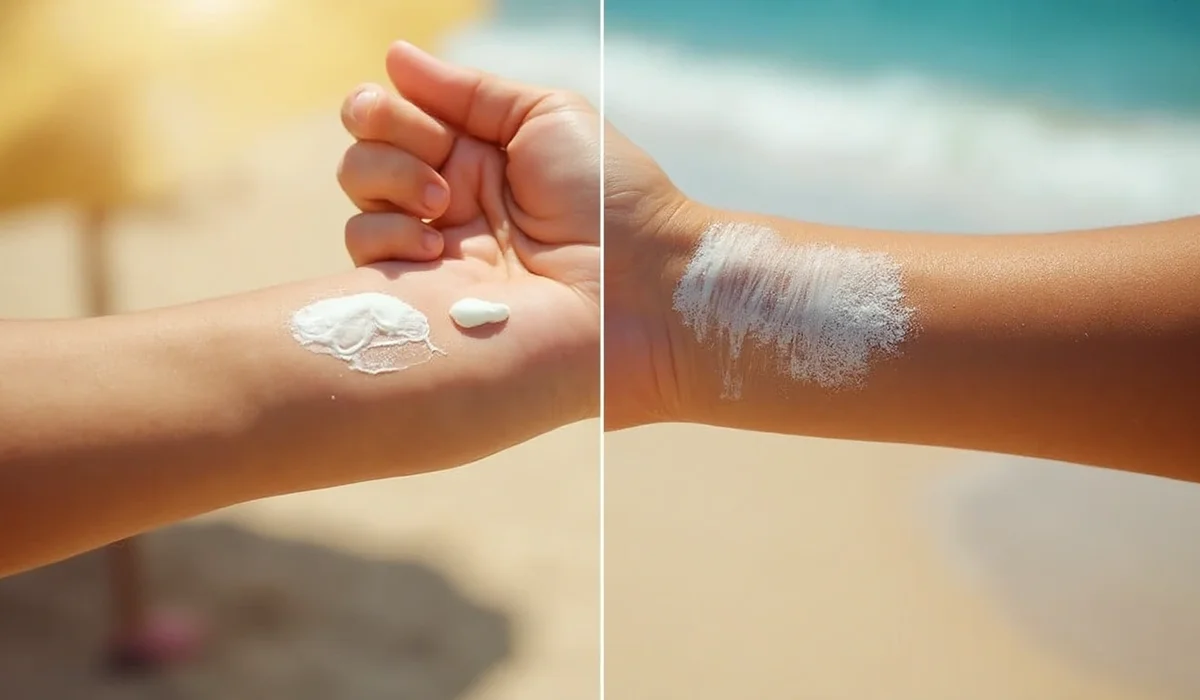Skin cancer will affect one in five Americans during their lifetime. The statistics are concerning, yet many people don’t grasp how sunscreen shields their skin or apply it properly. Research proves that daily SPF 15 sunscreen usage can cut the risk of squamous cell carcinoma by 40 percent and melanoma by 50 percent when people follow proper application instructions.
The phrase “proper application” makes all the difference. Dermatologists’ guidelines suggest using more sunscreen than most people typically apply. Most users put on less than half the recommended amount, which substantially decreases their protection. Sun exposure links directly to 90% of all skin cancer cases. Understanding sunscreen’s protective mechanism is a vital part of getting its full benefits. This piece will cover the common sunscreen application mistakes and teach you the right way to protect your skin from UV rays.
Why sunscreen is essential for skin protection
UV radiation exposure remains the biggest risk factor that leads to skin cancer. We need to understand how sunscreen protects your skin and recognize UV radiation’s immediate and lasting effects on our skin.
Does sunscreen prevent skin cancer?
Studies clearly show sunscreen’s effectiveness in preventing skin cancer. The largest longitudinal study with randomized controlled trials proves that people who use sunscreen regularly face lower risks of both squamous cell carcinoma and melanoma. Daily use of SPF30 cuts down DNA damage from sun exposure by about 53%. SPF100 works even better by reducing damage up to 73%. A detailed Australian study tracked participants who applied sunscreen daily for 4.5 years. These participants showed substantially lower risks of invasive melanoma (hazard ratio 0.27).
The importance of sunscreen beyond sunburn
Sunscreen’s benefits go way beyond the reach and influence of stopping painful sunburns. Your skin suffers clinically significant DNA damage even without visible redness. This happens at exposure levels nowhere near what causes sunburn. It also helps prevent:
- Early aging signs like wrinkles and skin color changes
- Lasting skin damage such as blotchiness and sagging
- Solar keratoses (precancerous lesions)
UV exposure impacts your skin’s immune system, which makes proper protection vital to your skin’s overall health.
How does sunscreen work to protect your skin
Your sunscreen shields skin through two main ways:
Physical blockers (like titanium dioxide and zinc oxide) create a protective shield that reflects and scatters UV rays before skin absorption. These minerals form a physical barrier on your skin’s surface.
Chemical sunscreens (such as avobenzone and octocrylene) work differently by absorbing UV rays like a sponge to prevent skin damage. These ingredients use aromatic compounds that convert high-intensity UV radiation into lower-energy wavelengths.
Broad-spectrum sunscreens blend ingredients to guard against both UVA rays (which go deep into skin causing lasting damage) and UVB rays (which cause sunburn and contribute most to skin cancer).
Understanding SPF and what it really means
You might recognize SPF as the biggest number on your sunscreen bottle, but many people don’t really know what it means. People think SPF (Sun Protection Factor) tells them how long they can stay in the sun without burning. The truth is different – it shows how well the sunscreen shields you from UVB radiation.
What SPF numbers actually tell you
SPF shows how much longer protected skin takes to redden compared to skin without sunscreen. To cite an instance, if your skin burns in 10 minutes without protection, SPF 30 should let you stay in the sun 30 times longer—about 300 minutes. In spite of that, this math only works with perfect application and doesn’t factor in how the sun’s strength changes throughout the day.
The numbers on SPF also tell you the percentage of UVB rays blocked:
- SPF 15 blocks approximately 93% of UVB rays
- SPF 30 blocks approximately 97% of UVB rays
- SPF 50 blocks approximately 98% of UVB rays
- SPF 100 blocks approximately 99% of UVB rays
SPF mainly measures how well you’re protected against UVB rays that cause sunburn, not the UVA rays that go deeper and lead to skin aging and cancer risk.
Why SPF 30 is often enough
Most dermatologists say SPF 30 gives you good basic protection. This level blocks about 97% of harmful UVB rays and helps prevent sunburn and skin damage. The Skin Cancer Foundation believes SPF 30 works well for daily use, but suggests SPF 50+ if you’ll be outside for a long time.
The American Academy of Dermatology also backs using sunscreen with at least SPF 30 that blocks 97% of UVB rays. This protection level is enough for most people in normal conditions if they apply it right and keep reapplying.
The myth of higher SPF being better
Higher SPF numbers might sound better, but they don’t add much protection. There’s only a 1% difference between SPF 50 (98% protection) and SPF 100 (99% protection). So the FDA wants to limit sunscreen labels to SPF 60+.
High-SPF products can make people feel too safe. They might stay in the sun longer, forget to reapply, or skip other protection like staying in shade or wearing proper clothes. This behavior ends up causing more UV damage.
There’s another reason why higher SPF isn’t always better. People think it protects longer, but that’s wrong. You need to reapply all sunscreens every two hours, or right after swimming or sweating.
Most people only use 20-50% of the sunscreen they should, which means they get less protection than what’s on the label. Using the right amount of sunscreen matters more than picking a very high SPF number.
Common mistakes people make with sunscreen
Your sunscreen won’t protect you well if you don’t apply it correctly. Let’s look at some common mistakes that could leave your skin vulnerable to damage.
Not using enough product
Adults need about 1 ounce of sunscreen to cover their exposed skin – that’s a full shot glass worth. Studies show people only use 25-50% of what they actually need. This cuts down protection substantially, no matter what the SPF number says. Here’s a simple way to measure: use two finger-lengths of sunscreen for your face and neck, and a shot glass full for your body. The difference between proper and improper application could mean the difference between protected skin and sunburn.
Skipping reapplication
You need to reapply sunscreen every two hours outdoors. This becomes even more important when you swim or sweat – you should put more on right after. Don’t skip this step just because it’s cloudy or cold outside. Many people think morning application protects them all day. This mistake leaves their skin exposed during the most dangerous UV hours.
Relying on makeup with SPF
SPF makeup gives some protection but doesn’t work well enough by itself. You’d need about 13 pumps of foundation to get the SPF level shown on the package. Most people use just 1-2 pumps because they want their makeup to look good. Dermatologists say you should put on regular sunscreen under your SPF makeup to stay protected.
Ignoring cloudy or winter days
Many think they don’t need sunscreen when it’s cloudy. UV rays cut through clouds 80% of the time. Snow makes things worse by reflecting up to 90% of UV rays back at you. The American Academy of Dermatology found that all but one of these Americans know winter sunburns can happen.
Missing key areas like ears and scalp
People often forget to protect their scalp, ears, eyelids, lips, neck, and feet. These spots have a high risk of skin cancer. About 20% of new melanoma cases show up on the head and neck. Your scalp needs extra attention because it faces the sun directly. A good protection plan includes SPF lip balm and scalp coverage for detailed protection.
How to choose and use sunscreen the right way
Picking the right sunscreen needs more thought than just grabbing any bottle from the shelf. Learning what makes sunscreen work will help you make smarter choices for your skin’s health.
Look for broad spectrum protection
Broad spectrum protection isn’t optional. This label shows the sunscreen shields you from both UVA (aging) and UVB (burning) rays. Only 39% of consumers think about broad spectrum protection when buying sunscreen, though it’s vital for skin health. The FDA runs thorough tests before a sunscreen can display this label to ensure UVA protection matches UVB protection. UVA rays make up more than 90% of UV radiation and penetrate clouds and glass throughout the year.
Choose dermatologist recommended sunscreen
Skin doctors recommend products with SPF 30 or higher for daily use, and SPF 60+ works best for long outdoor activities. Your sunscreen should be gentle on skin, free from fragrances, and work to protect your skin’s natural barrier. People with oily or acne-prone skin should pick non-comedogenic formulas that keep pores clear.
Mineral vs. chemical: what’s best for you?
Chemical sunscreens use ingredients like avobenzone and octinoxate that soak up UV rays like a sponge and turn them into heat. In stark comparison to this, mineral sunscreens with zinc oxide or titanium dioxide reflect and scatter UV radiation. The FDA calls these mineral ingredients “Generally Recognized As Safe and Effective”. Sensitive skin types usually do better with mineral options, while people who want invisible protection lean toward chemical formulas.
Water-resistant vs. waterproof explained
No sunscreen truly stays waterproof. The FDA banned “waterproof” and “sweatproof” labels in 2011 because they misled consumers. Sunscreens can only claim water resistance for 40 or 80 minutes. Products earn these ratings after tests show they keep their SPF after being in water for the specified time.
When and how often to apply
Start by putting on sunscreen 15-20 minutes before sun exposure so it can create a protective shield. Most adults need about one ounce – picture a shot glass full – to cover their whole body. You must reapply every two hours during outdoor activities and right after swimming or sweating, whatever the water resistance claim says. Indoor activities away from windows let you stretch the time between applications to 4-6 hours.
Conclusion
Protecting your skin from harmful UV rays needs more than just random sunscreen application. This piece shows that using sunscreen properly combines science and skill – something most people haven’t become skilled at yet. Many people stay vulnerable to skin damage even when they think they’re protected.
Daily sunscreen use substantially cuts your risk of skin cancer. The numbers prove it: 40% lower risk for squamous cell carcinoma and 50% for melanoma with correct application. But here’s the catch – “correct application” makes all the difference. Most people apply less than half the recommended amount, which cuts their protection by 50%.
Understanding SPF helps you make smarter choices. SPF 30 stops about 97% of UVB rays, making it good enough for daily protection when applied right. Higher SPF numbers give nowhere near enough extra benefit and might make you feel safer than you really are.
People make several key mistakes that need attention. These include using too little product, forgetting to reapply, depending only on makeup with SPF, skipping protection on cloudy days, and missing spots like ears and scalp. Each mistake weakens your skin’s defense system.
The best protection comes from broad-spectrum products that block both UVA and UVB rays. Your skin type determines whether mineral or chemical formulas work better. Note that “water-resistant” doesn’t mean “waterproof” – you still need to reapply after swimming or sweating.
Sunscreen might feel like a hassle, but the benefits outweigh this small inconvenience. Your future self will thank you for these extra minutes of proper skin protection each day. Preventing skin cancer starts with proper daily sunscreen use – maybe even the simplest yet most powerful health habit you can develop.




